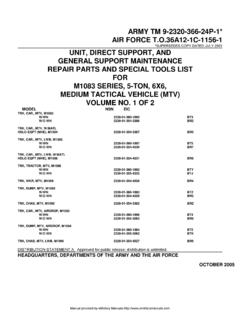Transcription of Reduced chemical kinetic mechanisms for methane …
1 Reduced chemical kinetic mechanismsfor methane combustionin O2/N2and O2/CO2atmosphereJ. Bibrzycki1and T. Poinsot21 Corresponding author: Silesian University of Technology,Institute of Thermal Technology, 22 Konarskiego St., 44-100 Gliwice, Poland2 Universit e de Toulouse, IMFT (Institut de M ecanique des Fluides de Toulouse)All ee C. Soula, F-31400 Toulouse, FranceAbstractTwo Reduced mechanisms (2S-CM2 and J-L) have been tested for a conventional air- methane com-bustion. Whereas, existing (2S-CM2 and J-L) schemes and refined ones (2S-CM2-JB2 and J-L-JB)were verified using detailed chemistry computations, for specified oxy-fuel conditions. Results for theair- methane case, obtained for the J-L scheme and for the GRI Mech, are in general in better agree-ment than those evaluated for the 2S-CM2. Large disagreement between detailed chemistry calcula-tions and results obtained for J-L and 2S-CM2 global schemes, for the oxy-fuel combustion , was foundfor freely propagating 1D laminar premixed flames.
2 Therefore, two new major schemes were evalu-ated (2S-CM2-JB2 and J-L-JB). Modified schemes improved the agreement with the detailed mecha-nism considerably, for both considering compositions of the oxidizer (XoxidO2=0,385/XoxidCO2=0,615 andXoxidO2=0,28/XoxidCO2=0,72).INTRODUCT IONC arbon dioxide emission reduction has become one of the main concern last years, due to the standpointof most of scientists, who work on climate change that a direct connection between global temperatureincrease and anthropogenic greenhouse gases emission exists. Carbon dioxide is a specie, which emis-sion cannot be avoided during combustion of the fuel containing carbon. Therefore, emission reductioncan be only done through sequestration. In order to underground storage of CO2, this specie has to beseparated from flue gases, which contain mainly nitrogen, what is a very expensive process.
3 One ofthe best ways to sequestrate CO2, is to perform a combustion without nitrogen presence in the oxidizer(oxy-fuel combustion ). Nevertheless, the combustion in pure oxygen leads to dangerous temperatureand flame speed escalation. In order to keep those two quantities at levels similar to air, a mixing ofoxygen with part of flue gases is performed, thus, a mixture containing O2/CO2is used as an dioxide has different heat capacity, thermal diffusivity and emissivity in comparison tomolecular nitrogen. Therefore, the combustion of the fuel in the oxidizer, containing the same molefraction of CO2as it is found for nitrogen in air, leads to significant parameters changes in comparisonwith conventional fuel-air combustion [14, 4, 7, 2, 3]. The emissivity of this flame changes due to thefact, that carbon dioxide is a three-atomic gas, which was the main topic of Anderson and Johnsson[4].
4 Benedetto et al. [2] indicated the decrease of laminar flame speed, while nitrogen was displaced bycarbon dioxide. The explanation for this behavior was the higher heat capacity of the CO2, which de-creasing the flame temperature and at the same time the combustion rate. The reaction kinetics undergoalterations when N2is displaced by CO2in the oxidizer. Favor of CO in CO-CO2equilibrium and H2inH2O-H2equilibrium was found in higher temperatures (>2500K) during oxy-fuel combustion [3].A computational fluid dynamics is an important toll for a design and a process optimization. Sim-ulation of full-scale geometry, with millions of cells, requires a large memory and long computational1time. In order to safe time required for simulations significantly, simplified combustion mechanisms areused. Schemes containing two (WD, 2S-CM2) [30, 6], four (J-L) [16] or more [31, 8] reactions can beused to describe the combustion phenomena, however, their accuracy is limited.
5 The mechanisms whichare created for a conventional combustion of fuel in air were found not to be satisfying for a oxy-fuelcombustion [3, 14], because every detailed mechanism has restricted area of aim of the present work was simulations in Cosilab of 0D and 1D methane combustion in theoxidizer containing N2/O2as well as CO2/O2. Firstly, the detailed mechanism results comparison fortwo different compositions of the oxidizer and finding the mole fraction of the carbon dioxide in theoxidizer, which results similar combustion conditions to the conventional combustion , were step was testing existing and new (created for oxy-fuel combustion ) Reduced schemes, where thereference results were obtained for detailed mechanism simulation. The 0D simulations were doneusing equilibrium calculations and auto-ignition delay times, while 1D computations were performedusing freely propagating laminar flames, stretched laminar premixed and diffusion QUANTITIESM olar and mass species fractionMole species fractions can be expressed according to Eq.
6 (1), while mass fractions are given by Eq. (2).Xi=ni/N ini(1)Yi=mi/N imi(2)Between those two quantities following relationship exists Eq. (3) [23].Xi=Yi(W/Wi)(3)In Eq. (1) and in Eq. (2) lettersnandmdenote respectively mole and mass quantities inkmolandkg, whereasWis the molar weight of gas mixture Eq. (4). Indexirepresents each specie,Ndeterminesthe total number of species in the gas iWi Xi(4)Molar concentrations can be calculated according to Eq. (5) [1]. is a density of the gas Yi/Wi(5) =pRzT(6)wherepandTis respectively the mixture pressure inPaand the temperature inK,Rzcan be evaluatedas follow:Rz=RW(7)whereRis universal gas constant inJ/(kmolK)Calculations of reactants mole fractionComposition of the fuel and oxidizer are following:Fuel:XCH4=1 Oxidizer:XoxidO2;Xoxidinert=1 XoxidO2 Species mole numbers in the fuel can be written as [26]:n C=1 XCH4=1kmolCkmolCH4n H2=2 XCH4=2kmolH2kmolCH4A stoichiometric amount of oxygen and oxidizer, which are required for complete combustion offuel, are evaluated as [26]:n O2min=n C+0,5 n H2=2kmolO2kmolCH43n oxidmin=n O2minXoxidinert,kmoloxidkmolCH4A real quantity of oxidizer used for combustion can be described as follow [26]:n oxid=n O2min ,kmoloxidkmolCH4where is oxidizer excess ratio and is a reciprocal of equivalence ratio ( =1 ).
7 Mole amount of oxygen and of inert gas, which participate in combustion , can be calculated as:n O2=XoxidO2 n oxid,kmolO2kmolCH4n inert=Xoxidinert n oxid,kmolinertkmolCH4 Homogenous premixed mixture molar fractions of species, which are required as a boundary con-ditions in Cosilab, can be derived finally from equation (1).Quantities related to diffusion flamesIdentification of the combustion regime can be done using mixture fraction (z), which calculates thelocal fuel/oxidizer ratio [23]:z=1 b+1 ( bYFY0F YOY0O+1)(8)whereY0 FandY0 Oare mass fractions of the fuel and oxygen at the boundaries on the fuel and oxidizerside respectively;YFandYOare local mass fractions of the fuel and oxygen equivalence ratio b(Eq. (8)) does not correspond to the global equivalence ratio, but character-izes the local structure of the diffusion flames [23]: b=sY0FY0O(9)where s is the mass stoichiometric ratio: [23]:s= OWO FWF(10)where Oand Fare stoichiometric coefficients of the overall (one-step) reaction corresponding to fueland oxidizer (8) is theoretical and does not account radicals, because is created for one-step mecha-nism, thus the real flame mixture fraction, for methane combustion , should be calculated from followingdependence [23]:zc=Zc 0Y0F Wc/WCH4(11)whereZcis passive scalar defined for theCelement and is calculated according to equation below [23].
8 Zc=WcN k=1akYkWk(12)whereakis the number ofCelements KINETICSI ntroduction of methane oxidation mechanismsIn this section particular methane oxidation mechanisms are presented, which were employed in calcu-lations. Three different mechanisms were taken as a basis for further development of mechanisms forCH4oxy-fuel combustion : GRI Mech [10], Jones-Linstedt (J-L) [16] and 2S-CM2 [6] (Table 1).New developed schemes are presented in Table 2. For existing as well as for new schemes the number ofspecies involved in the flame computation was depended on the composition of the oxidizer. Simulationof methane combustion in the oxidizer composed of N2/O2or of CO2/O2contains no argon, what limitsthe original GRI Mech number of reactions (325) and species (53). In the case of oxy-fuel combustionsimulation apart from argon also nitrogen is not present, thus the reduction of species and reactions (Ta-ble 1).
9 Table 3 presents reactions of 2-step and 4-step mechanisms while full specification of Arrheniusparameters (Eq. (13)) for those reactions are presented in Table 5 and Table 6. The full specification ofreactions for GRI Mech is available online [10].The reaction rate constant can be expressed according to the Arrhenius equation (Eq. (13)), whereAjis a pre-exponential constant, jis a temperature exponent, Ejis the activation energy of the reaction[23].kj=AjT jex p( EjRT)(13)The reaction rate progress is described as a difference between forward and backward reaction rates[1].rj=kfN iCi i kbN iCi i(14)Table 1:The existing chemical schemes used in this ofNumber ofUsage reasonoxidizernamespeciesreactionsCH4/ai rGRI Mech schemeCH4/air2S-CM2522-step scheme used in AVBPCH4/airJ-L (Jones-Linstedt)644-step schemeCH4/O2/CO2 GRI Mech schemeCH4/O2/CO22S-CM2522-step scheme used in AVBPCH4/O2/CO2J-L (Jones-Linstedt)644-step schemeTable 2:The new chemical schemes developed in this ofNumber ofUsage reasonoxidizernamespeciesreactionsCH4/ai r2S-CM2-JB152 Modified with PEA on the rich sideCH4/O2/CO22S-CM2-JB252 Modified by JB for oxy-fuel combustionCH4/O2/CO22S-CM2-JB352 Modified with PEA on the rich sideCH4/O2/CO2J-L-JB64 Modified by JB 4-step scheme5 Table 3.
10 Number of reactions for 2-step and 4-step Reduced mechanismsReaction2-step mechanisms4-step mechanismsnumber(2S-CM2, 2S-CM2-JB1, 2S-CM2-JB2, 2S-CM2-JB3)(J-L, J-L-JB)1CH4+1,5O2=>CO+2H2 OCH4+0,5O2=>CO+2H22CO+0,5O2<=>CO2CH4+H2O=>CO+3H23H2+0,5O2<=>H2O4CO+H2O<=>CO2+H2F = -1,8906 2 + 3,0238 - 0,1302F = -1,7172 2 + 1,7503 + 0,991400,10,20,30,40,50,60,70,80,9111,11 ,21,31,41,5 FO2=38,5% /CO2=61,5%airFigure 1:Function F plotted against equivalence ratio for air and 38,5%O2/61,5% the 2-step scheme is not able to predict the laminar flame speed for fuel-rich mixtures,two additional schemes were created (2S-CM2-JB1 and 2S-CM2-JB3) using pre-exponential factor ad-justment. Pre-exponential factor adjustment (PEA) is a method of redefining the reaction rate throughdefining the pre-exponential factor (A) as a function of the local equivalence ratio [11]. In this study itwas done through creation of correction functions for both air and 38,5%O2/61,5%CO2cases (Fig.)








